Human Orbital Spaceflights
![]()
International Flight No. 242Soyuz TMA-7RassvetRussia |
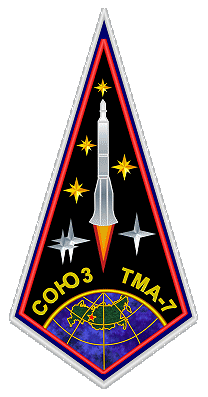 |
 |
![]()
Launch, orbit and landing data
walkout photo |
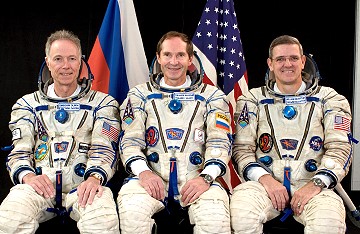 |
||||||||||||||||||||||
alternative crew photo |
|||||||||||||||||||||||
alternative crew photo |
|||||||||||||||||||||||
alternative crew photo |
Crew
| No. | Surname | Given names | Position | Flight No. | Duration | Orbits | |
| 1 | Tokarev | Valeri Ivanovich | Commander | 2 | 189d 19h 52m 20s | 2991 | |
| 2 | McArthur | William Surles, Jr. "Bill" | Flight Engineer | 4 | 189d 19h 52m 20s | 2991 | |
| 3 | Olsen | Gregory Hammond "Greg" | Spaceflight Participant | 1 | 9d 21h 14m 55s | 155 |
Crew seating arrangement
|
 |
|
||||||||||||||||
Backup Crew
|
 |
||||||||||||||||||||
alternative crew photo |
Hardware
| Launch vehicle: | Soyuz-FG (No. 1M133S P15000-017) |
| Spacecraft: | Soyuz TMA-7 (TMA No. 217) |
Flight
|
Launch from the Baikonur Cosmodrome and
landing 55 km northeast of Arkalyk. Gregory Olsen was another space tourist. This mission carried out the ISS Expedition 12. They were called a "caretaker" crew. Following a two-day solo flight Soyuz TMA-7 docked to ISS on October 03, 2005. Valeri Tokarev and William McArthur replaced the Expedition 11 crew. The first EVA was performed by William McArthur and Valeri Tokarev on November 07, 2005 (5h 22m) to install a television camera on the station's part truss, needed for future assembly work, to remove the 5 year old FPP experiment (Floating Potential Probe) from the top of the P6 truss and to remove and replace other equipment. On 18.11.2005 the Soyuz TMA-7 spacecraft was relocated from the Pirs docking port to the Nadir Docking port of the Zarya module. That was necessary to start the second EVA from out the Pirs Docking Compartment airlock. Progress M-55 was launched at 18:38:20 UTC on December 21, 2005. The spacecraft docked with the Pirs module at 19:46:18 UTC on December 23, 2005. Progress M-55 carried supplies to the International Space Station, including food, water and oxygen for the crew and equipment for conducting scientific research. The freighter remained docked for almost six months before undocking at 14:06:01 UTC on June 19, 2006 to make way for Progress M-57. It was deorbited at 17:06:01 UTC on June 19, 2006. The spacecraft burned up in the atmosphere over the Pacific Ocean, with any remaining debris landing in the ocean at around 17:53:14 UTC. The second and final EVA by William McArthur and Valeri Tokarev occurred on February 03, 2006 (5h 43m) to deploy SuitSat, an unneeded Russian spacesuit with an amateur radio transmitter. The SuitSat provided recorded greetings in six languages to ham radio operators for about two orbits of the Earth before it stopped transmitting, perhaps due to its batteries failing in the cold environment of space. They then removed a grapple fixture adapter for the Strela crane to the PMA-3 on the Unity module. Then they tried to securely install a safety bolt in a contingency cutting device for one of two cables that provide power, data and video to the Mobile Transporter rail car, but this failed. Finally, they retrieved an experiment to study the effect of the space environment on microorganisms from the Russian Pirs airlock and photographed the exterior of Zvezda. On March 20, 2006 the Soyuz TMA-7 spacecraft was relocated again, now from the Zarya module to the Zvezda port. Additional work during this mission included different research programs as Foot-Ground Reaction Forces during Space Flight experiment (FOOT), Protein Crystal Growth Monitoring by Digital Holographic Microscope for the International Space Station (PROMISS-4), Binary Colloidal Alloy Test, but also “housekeeping”, repairing work, unload and reload of Progress freighters and more. On March 29, 2006 a total solar eclipse took place, and pictures were taken by the Expedition 12 crew. They clearly showed the shadow of the Moon being cast on the Earth. The Soyuz spacecraft is composed of three elements attached end-to-end - the Orbital Module, the Descent Module and the Instrumentation/Propulsion Module. The crew occupied the central element, the Descent Module. The other two modules are jettisoned prior to re-entry. They burn up in the atmosphere, so only the Descent Module returned to Earth. The deorbit burn lasted 256 seconds (fuel needed: 266 kg, delta v = 115,3 m/s). Having shed two-thirds of its mass, the Soyuz reached Entry Interface - a point 400,000 feet (121.9 kilometers) above the Earth, where friction due to the thickening atmosphere began to heat its outer surfaces. With only 23 minutes left before it lands on the grassy plains of central Asia, attention in the module turned to slowing its rate of descent. Eight minutes later, the spacecraft was streaking through the sky at a rate of 755 feet (230 meters) per second. Before it touched down, its speed slowed to only 5 feet (1.5 meter) per second, and it lands at an even lower speed than that. Several onboard features ensure that the vehicle and crew land safely and in relative comfort. Four parachutes, deployed 15 minutes before landing, dramatically slowed the vehicle's rate of descent. Two pilot parachutes were the first to be released, and a drogue chute attached to the second one followed immediately after. The drogue, measuring 24 square meters (258 square feet) in area, slowed the rate of descent from 755 feet (230 meters) per second to 262 feet (80 meters) per second. The main parachute was the last to emerge. It is the largest chute, with a surface area of 10,764 square feet (1,000 square meters). Its harnesses shifted the vehicle's attitude to a 30-degree angle relative to the ground, dissipating heat, and then shifted it again to a straight vertical descent prior to landing. The main chute slowed the Soyuz to a descent rate of only 24 feet (7.3 meters) per second, which is still too fast for a comfortable landing. One second before touchdown, two sets of three small engines on the bottom of the vehicle fired, slowing the vehicle to soften the landing. During the stay on board of the ISS the crew of Expedition 12 carried out the following scientific experiments: ADUM (Advanced Diagnostic Ultrasound in Microgravity), Akvarium (Study of the Stability of a Model of Self-Contained (Closed) Ecological System and Elements, Included in the Model in Microgravity), ALTCRISS (Alteino Long Term Cosmic Ray Measurements on board the International Space Station), ARISS (Amateur Radio on the International Space Station), BCAT-3-4-CP (Binary Colloidal Alloy Test - 3 and 4: Critical Point), BCAT-3-SC (Binary Colloidal Alloy Test - 3: Surface Crystallization), Biodegradation (Initial stage of Biodegradation and Biodeterioration in Space), Bioekologia (Generation of High Efficiency of Microorganisms for the Production of Preparations of Biodegradable Oil, Organophosphorus Material, Measures for the Protection of Plants, as well as, of Exopolysaddharides Uses in the Petroleum Industry), Bioemulsia (Research and Development of a Self-Contained Reactor of the Shielded Type For Production of Biomass of Microorganisms and Biologically Active Substances), Biorisk (Influence of Factors of the Space Environment on the Condition of the System of Microorganisms-Hosts Relating to the Problem of Environmental Safety of Flight Techniques and Planetary Quarantine), Cardio-ODNT (Dynamics of the Main Factors of Cardiac Function, of Central and Regional Circulation in Rest and During the Influence of Lower Body Negative Pressure), Cardiocog-2 (Cognitive Cardiovascular Experiment), CBOSS-FDI (Cellular Biotechnology Operations Support Systems: Fluid Dynamics Investigation), CEO (Crew Earth Observations), CFE (Capillary Flow Experiment), Chromosome-2 (Cytogenetic Effects of Ionizing Radiation in Peripheral Lymphocytes of ISS Crewmembers), Clinical Nutrition Assessment (Clinical Nutrition Assessment of ISS Astronauts, SMO-016E), Conjugation (Development of Methods for Designing New Recombinants Producing Strains of Bacteria in Space Flight), Diatomeya (Stability of Geographical Position and Configuration of Borders of Bioproductive Water Zones of the World Oceans, Observations by Orbition Station Crews), EarthKAM (Earth Knowledge Acquired by Middle School Students), Ekon (Experimental Survey on Evaluating the Possibility of Using th Russian Segment of ISS for Environmental Inspection of Work Areas of Various Facilities (Features)), Environmental Monitoring (Environmental Monitoring of the International Space Station), EPO-Demos (Education Payload Operation - Demonstrations), Epstein-Barr (Space Flight Induced Reactivation of Latent Epstein-Barr Virus), Foot (Foot Reaction Forces During Space Flight), Gematologia (Morphofunctional Characteristic of Blood Cells and the Intensity of Erythropoiesis in Humans by the Influence of Factors of Space Flight), Identifikatsia (Identification of the Sources of Dynamic Loads on ISS), Immuno (Neuroendocrine and Immune Responses in Humans During and After Long Term Stay at ISS), Inflight Education Downlinks (International Space Station Inflight Education Downlinks), InfoTekh (S Band Radio Signal Passage Through ISS and Test of Data Downlink), InSPACE (Investigating the Structure of Paramagnetic Aggregates from Colloidal Emulsions), ISS Acoustics (International Space Station Acoustic Measurement Program), Izgib (Effect of Performance of Flight and Science Activities on the Function of On-Orbit Systems on ISS (Mathematical Model)), JAXA-GCF (Japan Aerospace and Exploration Agency - Granada Crystallization Facility High Quality Protein Crystallization Project), Journals (Behavioral Issues Associated with isolation and Confinement: Review and Analysis of Astronaut Journals), Kristallizator (Crystalization of Biological Macromolecules and Generation of Biocrystal Film in the Conditions of Microgravity), Kromka (Verification of the Effectiveness of Devices for the Protection of the Exterior Surface of ISS from Contaminants Deposited by Pulsed Cycling of Liquid-Jet), Meteoroid (Recording Meteoroidal and Technogenic Particles on the External Surface of the Service Module of the Russian Segment of ISS), Mezhkletochnoe Vzaimodeistvie (Intercellular Interactions in Space Flight), MISSE-5 (Materials International Space Station Experiment - 5), Mobility (Promoting Sensorimotor Response Generalizability: A Countermeasure to Mitigate Locomotor Dysfunction After Long-Duration Space Flight), Muscle (Study of Low Back Pain in Crewmembers During Space Flight), NOA-2 (Exhaled Nitric Oxide-2), Pharmacokinetics (Pharmacokinetics and Contributing Physiologic Changes During Spaceflight, DSO 632B), Pilot (Individual Characteristics of Psychophysiological Regulatory Status and Reliaility of Professional Activities of Cosmonauts in Long Duration Space Flight), Plasma-MKS (Plasma-ISS: Examination of Plasmic Environments on the External Surface of ISS Through the Characterization of Optical Radiance), Plasma Crystal (Dusty and Liquid Plasma Crystals in Conditions of Microgravity), Plasma Interaction Model (Analysis of International Space Station Plasma Interaction), Profilaktika (Mechanisms of Action and Influence, and Effectiveness of Various Methods of Phrophylaxis Directed Toward Prevention of Disturbances of the Human Locomotion System in Weightlessness), Prognoz (Development of a Method of Operational Prediction of Work Load on Crew Piloting Objectives), Pulse (Vegatative (Autonomic) Regulation of the Cardio-Respiratory System of Humans in Conditions of Weightlessness), Radioskaf (Creation of Preparation and Launch in the Prcess of Mini-Satellites), Rastenia (Growth and Development of Higher Plants through Multiple Generations), Regeneratsia (Effect of Weightlessness on Processes of Regeneration by Electrophysiological and Morphological Factors), Relaksatia (Processes of Relaxation in the Ultraviolet Band Spectrum by High Velocity Interaction of Exhaust Products on ISS), Renal Stone (Renal Stone Risk During Spaceflight: Assessment and Countermeasure Validation), ROKVISS (Robotic Component Verification on the ISS: Verification of Lightweight Robotic Hinge Elements in Space), Sample (Study of Microbial Communities Exposed to Weightlessness), SKR (Skorpion: Development and Acquisition of Multifunctional Control-Measurement Device for Controlling the Environment of Scientific Experiments Inside a Pressurized Station), SNFM (Serial Network Flow Monitor), Sprut-MBI (Determination of Intracellular and Extracellular Fluid Volume in Humans in Space Flight), Sreda (Examination of the Features of IS as an Environment for Conducting Research), Statokonia (Growth Potency of Statoconia (Otoliths) in the Organ of Equilibrium of Gastropod Mollusks in Weightlessness), Suitsat-1 (Suit Satellite-1), SVS (CBC: Self-Propogating Hyperthermal Synthesis in Space), Uragan (Hurricane: Experimental Development of Groundbased System of Monitoring and Predicting the Progression of a Naturally Occurring Technogenic Catastrophe), Vektor-T (Study of a High Precision System for Prediction Motion of ISS), Volny (Waves: Observation in near Infrared Spectral Band Undulatory Disturbance in the Middle Atmosphere Layers of the Earth of Technogenic and Naturally Occurring Origin). |
EVA data
| Name | Start | End | Duration | Mission | Airlock | Suit | |
| EVA | McArthur, William | 07.11.2005, 15:32 UTC | 07.11.2005, 20:54 UTC | 5h 22m | ISS-12 | ISS - Quest | EMU No. 3009 |
| EVA | Tokarev, Valeri | 07.11.2005, 15:32 UTC | 07.11.2005, 20:54 UTC | 5h 22m | ISS-12 | ISS - Quest | EMU No. 3010 |
| EVA | McArthur, William | 03.02.2006, 22:44 UTC | 04.02.2006, 04:27 UTC | 5h 43m | ISS-12 | ISS - Pirs | Orlan-M No. 25 |
| EVA | Tokarev, Valeri | 03.02.2006, 22:44 UTC | 04.02.2006, 04:27 UTC | 5h 43m | ISS-12 | ISS - Pirs | Orlan-M No. 27 |
Note
Relocations of Manned Spacecrafts
| Spacecraft | from | Undocking | Time UTC | to | Redocking | Time UTC |
| Soyuz TMA-7 | ISS - Pirs | 18.11.2005 | 08:45:13 | ISS - Zarya | 18.11.2005 | 09:04:51 |
| Soyuz TMA-7 | ISS - Zarya | 20.03.2006 | 06:49:22 | ISS - Zvezda | 20.03.2006 | 07:11:23 |
Photos / Graphics
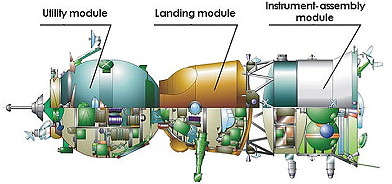 |
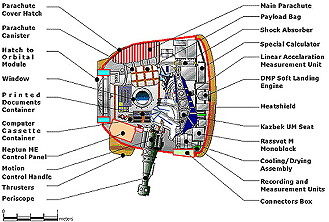 |
 |
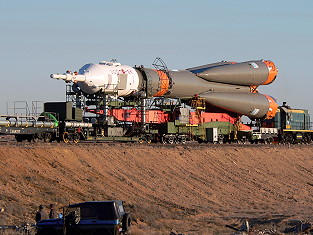 |
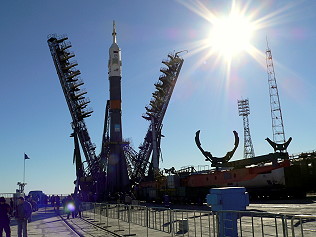 |
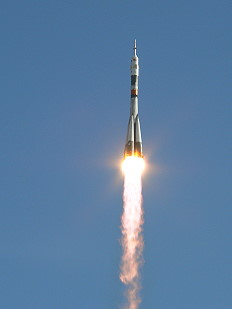 |
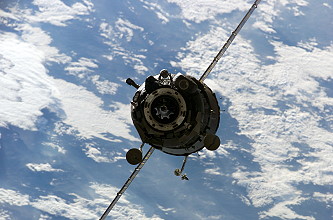 |
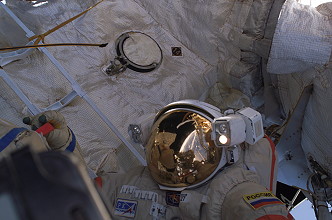 |
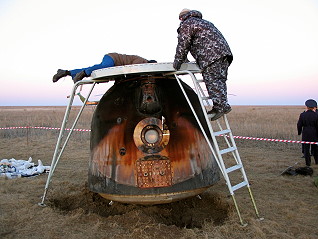 |
| © |  |
Last update on March 29, 2020.  |
 |